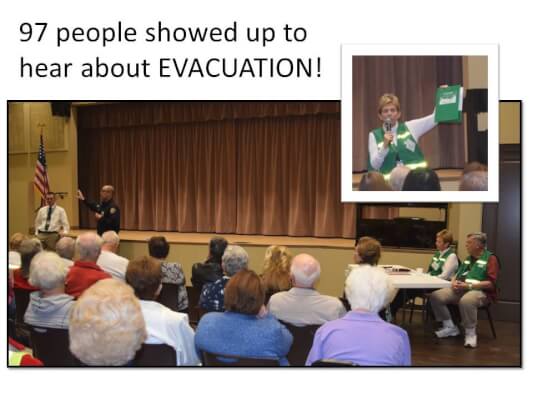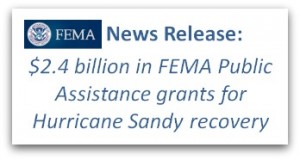“What do we do?” “Where do we go?”
 After the wildfires last fall, we kept hearing these two questions from a number of our California neighbors.
After the wildfires last fall, we kept hearing these two questions from a number of our California neighbors.
The questions seem simple, but people were not satisfied with what they were hearing.
So, we invited the local fire department to address the topic at a special community meeting. Nearly 100 people showed up that evening to get answers to the questions we had sent in advance.
Here are some of the questions we sent, and some of the answers we got. I recommend you consider finding out what YOUR local First Responders would say if asked.
“How will we know if we are supposed to evacuate?”
An evacuation order can come from the governor, the mayor, or the fire department. In every case, once the decision is made, the order will be announced via television, radio, various social media (Facebook and Twitter), the app iAlert, reverse 911 services – and even loudspeakers on cars or trucks.
Your job is to be aware of the POSSIBILITY of an order, and be ready to act when it comes. That means, at the very least, having your Evacuation Kit packed and your car full of gas. Having a battery-operated emergency AM radio will keep you up to date if power goes out.
“Where are we supposed to go?”
When an order is given, it is typically accompanied by a list of shelters that will be available. The addresses of the shelters will be given, and new shelters will be added as the incident evolves. (In our community, all high schools and community centers are prepared to serve as shelters.)
You can download the FREE Red Cross Shelter App for your Smart Phone and get a list of all open shelters in your area. (Look for Emergency App at the Red Cross site.)
Shelters are set up by the Red Cross and staffed by Red Cross and other volunteers, including CERT volunteers. Note that service animals are allowed in the shelters, but pets are NOT ALLOWED. You need to make arrangements for your pet beforehand!
“When is the best time to leave?”
Our speaker from the Fire Department emphasized that you do NOT need to wait for the order. You can leave any time you want – and sooner may be better than later. He told us that when the fire department arrived in one community where the order had just been given, everyone was already gone!
Of course, you don’t need to go to a shelter. You can stay with friends or relatives, stay in a hotel, etc. (If you have a pet, you may want to put together a list of pet-friendly hotels long before you might need one.)
Note: Once an order is given, and you have left your home, you will NOT BE ABLE TO RETURN until the official all-clear is given. Police need to be able to secure the neighborhood so fire fighters and other emergency personnel can move freely and safely.
“What about traffic?”
Cities usually plan for evacuation in phases, with specific traffic patterns laid out in advance. Streets can be converted to all-one-way. Unfortunately, in widespread evacuations as we saw in Florida last year, even freeways can become parking lots as everyone heads out in the same direction. (I don’t know why those Florida freeways weren’t converted to all-one-way!)
We saw during the Northern California fires, and later during the mudslides in Santa Barbara County that evacuation orders were delayed precisely because officials feared panic and traffic jams – and those officials have come under severe criticism. This is a tricky problem.
But it’s another reason for you to evacuate early if you can.
“How long can we stay in a shelter?”
Per the Red Cross, shelters stay open “as long as there is a need.” At the same time, while the shelter provides basic food and a place to sleep, the Red Cross recommends you bring your own supplies to make your stay more comfortable. On their suggested list:
- Prescription and emergency medication · medical equipment such as a wheelchair/walker, oxygen, etc.
- Extra clothing · pillows · blankets and sleeping bags
- Hygiene supplies
- Flashlight with extra batteries
- Small board games · books for entertainment
- Specialty snacks and juices for those with dietary restrictions
- Baby food and formula · diapers
- Beach chair or camp chair
You may NOT bring illegal drugs, alcoholic beverages or guns.
“What about people who can’t evacuate without help?”
Our Fire Department and the head of the Office of Emergency Management assured us that they know our community well enough to know where extra help would be needed – at hospitals, nursing homes, etc. Our speakers also agreed that having a current list of neighbors who would need extra help would be invaluable.
Unfortunately, putting together such a list is a challenge. In our senior community, our emergency response team attempts to collect information about neighbors. But some people are unwilling to provide the personal medical or financial information that would direct special assistance to them in an emergency. So, our list is always incomplete. Have you had success building a list?
“How should we prepare our homes before we leave?”
Fire. Here in California, where the danger is likely to be from fire, we are told by CalFire to take the following steps to protect our homes:
- Build using fire-resistant materials.
- Clear out underbrush and overhanging branches from around the home. (Create a “defensible space.”)
- Block vents and under-eave spaces where embers can catch and smolder.
- Remove curtains and move flammable furniture away from windows.
- Remove flammable lawn furniture and other outdoors hazards.
- Shut windows and doors and leave them unlocked.
- Leave the lights on (to direct fire fighters if it’s smoky).
- Do NOT leave water or sprinklers running (will lessen water pressure for professional fire fighters).
Flooding. In areas where flooding is the risk, suggestions include:
- Make serious changes to the way your home is built: make sure electrical panels, appliances and heating systems are elevated, not in the basement.
- Waterproof your basement.
- Raise the whole house (stilts?).
- Clean out gutters, downspouts and drains.
- Move items you want to protect to a higher floor or to a safer place altogether.
- Before you leave, turn off gas, water, and electricity if you know how and can do it without touching water or standing in it!
- Put sandbags around your property.
Hurricane a risk? Again, some basic precautions before you leave:
- Close storm shutters or board up windows with 5/8” plywood, cut to fit.
- Install addition clips or straps to fasten roof to the frame.
- Clean out rain gutters and downspouts.
- Determine how and where to secure your boat.
- Unplug radios, TVs, and small appliances (not refrigerator or freezer).
- If you live in a mobile home or a high-rise apartment, evacuate for sure. These structures are more vulnerable to both wind and flooding.
Now, consider these last three steps everyone can take.
Start To Work Now On These Longer-Term Protections
Check Your Insurance.
By now, you should know if you are in a burn corridor, a flood plain, an inundation footprint (from a dam collapse) or in a coastal area where your home could be impacted by a hurricane or tsunami. The right insurance policy could help protect you in the aftermath of one of these disasters. It’s likely that your regular homeowner’s policy will not be sufficient. Check with your insurance carrier and do preliminary research yourself, online.
You can start here with our Advisory: Flood Insurance
Get Involved In Your Community.
With so many disasters happening lately, many people are taking political action to strengthen their communities.
First, they are forcing community leaders to reconsider zoning and building codes and their enforcement. (Think about the massive landslide in Washington State where homes were build below a hill that had been identified as unstable. Think about the new homes built flat on the flood plain in Houston.) People are demanding better emergency alerts and automated communications.
Second, they are building community emergency response groups, so knowledge and assets can be shared in case of a disaster. (You saw Joe and me at the table in the picture at the top of the article. Later — the inset — I jumped in to wave the information about upcoming CERT classes in our city!)
Neighbors are the true first responders — they are already there when the disaster hits. You want the most qualified neighbors possible!
Pack Your Evacuation Kits.
This entire article assumes you have a kit ready for each member of the family in case an evacuation is called. Our Fire Department speaker mentioned just three things: Food, Water and Medicines. For a more complete list, check out our complete list of Emergency Supplies — scroll down to the Evacuation Kit section.
This turns out to be quite a list. I hope it’s useful as a review or to stimulate some remedial action on your part.
Virginia and Joe
Your Emergency Plan Guide Team
P.S. This isn’t the entire list of questions we came up with for our guest speakers. If you are thinking of approaching YOUR fire department and police department, drop me a line and request “the full list of evacuation questions” and I’ll send it to you directly. Naturally, you’ll want to customize your list. But we have found over the years that by providing speakers with questions we get a much better presentation than if we just invite them to “come give us a talk about safety!”



 After the wildfires last fall, we kept hearing these two questions from a number of our California neighbors.
After the wildfires last fall, we kept hearing these two questions from a number of our California neighbors. More resources for items on the list.
More resources for items on the list. Rebuilding in disaster-prone areas is a big issue.
Rebuilding in disaster-prone areas is a big issue.